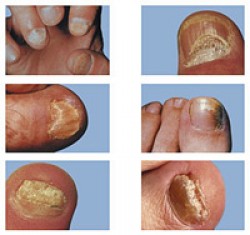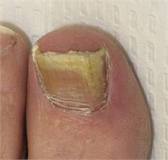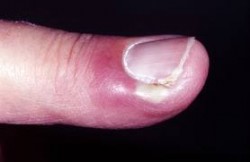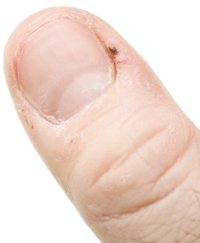Archive for the ‘Nail Fungus Infection’ Category
A Doctor’s Detailed Description of Onychomycosis
A Doctor’s Detailed Description of Onychomycosis
 Onychomycosis is the medical term for a fungal infection of the fingernails or toenails. Onycho refers to the nail, mycosis refers to fungal infection. This condition represents about 33% of all fungal skin infections. Approximately half of all diagnosed diseases of the fingernails or toenails are onychomycosis.
Onychomycosis is the medical term for a fungal infection of the fingernails or toenails. Onycho refers to the nail, mycosis refers to fungal infection. This condition represents about 33% of all fungal skin infections. Approximately half of all diagnosed diseases of the fingernails or toenails are onychomycosis.
Onychomycosis usually occurs in older people, most commonly 40 and above. The likelihood of the disease occurring in adults rather than children is about 30%. Onychomycosis is a regularly occurring disease and the chances of contracting it increase as people age. Approximately 20% of all people between the ages of 40 and 60 have onychomycosis. It is thought that upwards of 90% of elderly patients have it.
Onychomycosis occurances
Onychomycosis occurs more regularly in men than in women, however women are more likely to contract a specific type of the fungus called Candida. The disease seems to have no preference in race. There has been an increase in the number of cases of onychomycosis in recent years. Doctors believe this has to do with people living longer, thus facing the greater probability of diseases that are common causes of onychomycosis. For instance, the level of diabetes has increased in the population as well. The same corollary can be drawn between the aging population and the number of people with diabetes. Interestingly enough, having diabetes makes it more likely that a patient will contract onychomycosis as diabetics have a harder time fighting off infection and healing from wounds. Poor circulation is another commonly related disease as people who suffer from this have a less healthy immune system.
The most common symptom and complaint of sufferers of onychomycosis is the disfiguration of the nail. One of the greatest difficulties in catching a fungal nail infection early on is that it doesn’t present serious symptoms, especially in the beginning, when it is easiest to cure.
The fact that onychomycosis disfigures the nail is not to be disregarded. It causes people to avoid certain social interactions because of the embarrassment they feel having a nail fungus will bring. They become concerned that a fungal infection is infectious or that they will be seen as “unclean” or “unhealthy”. It is of serious concern to doctors, the psychological and emotional effect that onychomycosis can have on people.
Although this disease starts as a series of cosmetic symptoms, if left unchecked it can develop into a far more serious set of problems. Pain in the affected finger or toe can occur. Because the nail thickens, it deadens the sensitivity in the affected digits. This can lead to loss of sensation and therefore ability in the hands and feet. Tasks like writing and other daily activities are affected by fingernail fungus, being able to sense the floor, causing difficulty with walking and even causing serious falls, are an advanced symptom of toenail fungus. For patients who are already affected by diseases that cause problems with the nerves in the legs, this can make things even worse.
There are four main types of onychomycosis:
- Distal subungual onychomycosis – This is the most common form of onychomycosis and is caused by a dermatophyte called Trichophyton rubrum. What happens is the dermatophyte penetrates the nail plate and buries itself in the nail bed. The term ‘subungual’ refers to underneath the nail. The infection manifests as a whitish-yellow growth under and on the nail towards the tip (the part you trim) This then works its way down toward the cuticule and underneath to the nail bed. The nail becomes thick, pitted, ridged and can start to crumble.
- Proximal subungual onychomycosis – starts at the cuticle end of the nail instead of at the tip. It then works its way up the nail and under the nail as the nail grows out. This form of nail fungus infection occurs more regularly in people who have issues with immune deficiency. Proximal subungual onychomycosis is caused by Trichophyton ruburm, just as distal subungual onychomycosis is, but it is also caused by other fungi and molds.
- White superficial onychomycosis – This is probably the least commonly occurring form of onychomycosis, happening in only 1 of 10 cases on average. This fungus develops on the top of the nail or in its topmost layers. As the name ‘white superficial’ would imply, this is a lesion that forms at the top of the nail and is white in color. Gradually, the fungus will take over the entire nail if left unchecked. Unlike most other forms of onychomycosis, white superficial onychomycosis is caused by Trichophyton mentagrophytes, a different dermatophyte.
- Candida onychomycosis – This final form of onychomycosis starts out its life as chronic mucocutaneous candidas, or reoccurring mucous level or low level yeast infection. This tends to affect the skin surrounding the nail, specifically in the proximal and lateral nail folds. Usually multiple nails are affected by Candida onychomycosis and the nails can be fully destroyed by this more serious form of fungal infection.
References
Hainer BL. Dermatophyte infections. Am Fam Physician 2003;67:101-108.
Jaffe R. Onychomycosis: recognition, diagnosis, and management. Arch Fam Med 1998;7:587-592.
Kaur R, Kashyap B, Bhalla P. Onychomycosis–epidemiology, diagnosis and management. Indian J Med Microbiol 2008;26:108-116.
So How Do I Tell if My Toenail is Infected With a Fungus?
So How Do I Tell if My Toenail
is Infected With a Fungus?
 Having a nail that is infected with a fungus is not all that uncommon as it affects 10-12% of the American population. A toenail fungal infection is caused by microorganisms that lodge in the tiny cracks in the skin around the toenails. As the foot usually lives in a dark, damp environment, this is an ideal growing medium for the fungal spores. The symptoms of a fungal toenail infection are fairly consistent and if you know what to look for it is easier to catch it early on.
Having a nail that is infected with a fungus is not all that uncommon as it affects 10-12% of the American population. A toenail fungal infection is caused by microorganisms that lodge in the tiny cracks in the skin around the toenails. As the foot usually lives in a dark, damp environment, this is an ideal growing medium for the fungal spores. The symptoms of a fungal toenail infection are fairly consistent and if you know what to look for it is easier to catch it early on.
The first symptom to show up is usually a white or yellowish spot on the toenail. This may be a minute object, which makes it harder to recognize. This spot is the beginnings of the infection and will gradually grow to cover more of the nail. As most people don’t suffer any discomfort and with the advent of wearing nail polish, many people don’t even notice this minor change.
As the infection continues, the small spot will increase and cover the entire toenail. The toenail will become dull, yellowed and even change shape. Some people see a dark spot either where the infection began or around the edges of the toenail, though this happens more frequently with severe cases. At some point, the nail may become disconnected from the nail bed.
Nail becoming yellow and thick?
The process of the nail becoming yellow and thick is a classic toenail fungus symptom. Also common is flaking or crumbling of the toenail, which again occurs in the severe cases of the disease.
The only way to determine whether your symptoms are that of a toenail fungal infection or are the result of something that mimics these symptoms is to see your doctor. At that point your doctor will be able to ask you some questions and take a sample of your toenail to be examined under a microscope and/or cultured. Be sure to tell your doctor if you have spent time in a public pool or spa lately as this may increase your chances of contracting a toenail fungus infection.
Ask the doctor
Once your doctor has been given the chance to examine and sample your toenail, a solution will be able to be found that will be most effective for you. This will help your doctor determine which medication will be best for your particular infection. Toenail funguses are notoriously difficult to treat and cure, so allowing your doctor to get all the pertinent information will help you both to make an informed decision. One of the problems with nail funguses is that they all tend to display the same symptoms but that doesn’t mean they require the same treatment. And there are other conditions that will mimic the standard symptoms of a nail fungus, so working with your doctor to come up with the best treatment is in everybody’s interest.
Paronychia
Paronychia
 aronychia is a disease of the Perineum, where the skin around the surface of the nail hangs loosely. It has been found most often in the U.S., usually in kids who have a habit of biting their nails or sucking their fingers. There two forms of Paronchial infection, Chronic Paronychia and Acute Paronychia. The forms are judged according to the length of time it remains in the body.
aronychia is a disease of the Perineum, where the skin around the surface of the nail hangs loosely. It has been found most often in the U.S., usually in kids who have a habit of biting their nails or sucking their fingers. There two forms of Paronchial infection, Chronic Paronychia and Acute Paronychia. The forms are judged according to the length of time it remains in the body.
Paronychia is a viral infection that grows gradually stronger, resulting in a bumpiness, softness and redness surrounding the nails. The main culprits for this infection are Candida and mold. It can be passed from person to person via touch.
Causes of Paronychia
Most forms of Paronychia occur by a nick or break in the skin being infected. If a person has a hangnail or a habit of chewing their nails, this is a good way for the infection to enter the area. There is evidence of Streptococcus and Pseudomonas germs getting into the infected area and making it worse. The chronic form of Paronychia is typically linked with the use of abrasives, for instance soaps and detergents while washing. The chronic infections are typically the result of Candida albcans or other fungus.
Acute Paronychia occurs when the skin around the nail becomes inflamed and swells causing pain to the afflicted person. Pus may develop and ooze from the infected area, removing the top layer of the nail.
Chronic Paronychia is a longer lasting case and the nails can become so infected that they develop a greenish tinge around the edges of the skin.
Diagnosis
In the cases of Acute Paronychia, a culture of the pus can be taken to determine what kind (or kinds) of infection is occurring and then treatment can be prescribed. Chronic Paronychia can be a bit more difficult to diagnose and treat, though a potassium hydroxide test may be able to determine which fungus is the source of the infection.
Treatment
- Massaging the afflicted area in hot water three to four times per day can help relieve some of the pain and swelling
- Antibiotics such as diclogacilin and cephelaxin may be prescribed
- If the swelling is severe, the area may need to be punctured and drained
- Part of the nail may need to be removed in some cases
- An antifungal may also be prescribed
Things that should NOT be used to cure Paronychia
- Do not use topical antibiotics
- Do not take prescribed steroids
Unusual cases of people who have contracted Paronychia have occurred in patients with:
- HIV/AIDS
- On steroids
- High blood sugar
- Poor circulation
Prevention
- Don’t chew or bite your nails
- Don’t suck on your fingers or thumbs
- Don’t immerse your hands in water without wearing protective gloves
About the Condition Called Hangnails
About the Condition Called Hangnails
 Everyone wants to have healthy, attractive nails. However many people have hangnails. It is probably the most common nail ailment that humans face. There are various things we can do to prevent hangnails from developing and destroying the aesthetic beauty of the hand. Hangnails are not only unattractive, they tend to catch on hair, clothing, and other surrounding objects and can cause sudden and severe pain if they are bent backward to far. Many people look for ways to stop development of this irritating little problem. There are some simple solutions to avoiding hangnails.
Everyone wants to have healthy, attractive nails. However many people have hangnails. It is probably the most common nail ailment that humans face. There are various things we can do to prevent hangnails from developing and destroying the aesthetic beauty of the hand. Hangnails are not only unattractive, they tend to catch on hair, clothing, and other surrounding objects and can cause sudden and severe pain if they are bent backward to far. Many people look for ways to stop development of this irritating little problem. There are some simple solutions to avoiding hangnails.
What is a Hangnail?
Excess skin builds up around the base and side of the nail, the partially detaches from the nail itself, causing it to stick up and bend back. This can be very painful, as can trying to remove the hangnail, whether by cutting, biting or ripping it off.
What Causes Hangnails?
Hangnails are usually caused by dry cuticles. The cuticle is the skin that surrounds the nail, most commonly seen at the base of the nail. When the cuticle dries out it breaks and the skin detaches from the nail, creating a hangnail. If a person with a hangnail picks at it, bites at it or rips it off, it makes it more likely that this condition will continue as it just exacerbates the problem. People who spend a lot of time with their hands in water tend to suffer from hangnails as the skin gets soft and is then easily damaged. People who bite their nails are also more prone to hangnail. Children who bite their nails are usually afflicted with this nuisance.
How Do I Prevent Hangnails?
The easiest way to prevent hangnails from developing is to moisturize the cuticles. This is definitely a situation where preventing the problem is far better than dealing with it once it has occurred.
Some simple hangnail prevention tips:
- Don’t bite or rip off your hangnails. This frequently causes bleeding and may lead to infection. Use a small nail scissor to cut it close to the base which will inhibit further deterioration.
- Soak your hand in warm water for 5-10 minutes, dry thoroughly, then apply a moisturizing cream or oil to the skin surrounding the nails.
- Learn to stop biting your nails. If it’s really hard to stop, then investigate products that you can apply to your nails that will make them taste bad to help you resist the urge.
- Wear protective gloves when using harsh cleaning products or when you will have your hands immersed in liquid for a long period of time.
Living With A Nail Fungus Infection
Living With A Nail Fungus Infection
Having a nail fungus infection does not single you out, in fact it makes you part of the 20% of the world population that is also afflicted with this disease. Although it is unsightly, it is possible to live with, and cure, if you’re willing to put in the effort it may take. If you’re reading this, you may already be affected with this rather common disease. Below is more information to help you.
Nail fungus is a microorganism that lodges and grows on and under the nail. It can occur on both the finger and toenails. In fact, it’s really not a very discriminating fungus as it will happily grow anywhere it can. The biggest problem with nail fungus is not that it can do much harm, but that it takes so long for an infected person to notice the discoloration in their nail, and usually even longer for them to do anything about it. By then, the fungus has worked its way underneath the nail sheath and into the nail bed where it is much harder to get at. The fungus’s goal is to find a warm, wet place to survive. The infected person’s goal is to get rid of the fungus and get their healthy nail back! The faster you notice and start treating a fungal nail infection, the more likely you are to cure yourself of it.
 Avoid Becoming Infected in the First Place
Avoid Becoming Infected in the First Place
The simplest solution to a nail fungus infection is not to get it to begin with. There are lots of easy precautions you can take to avoid this disease.
- Think carefully about your regular day and where you might come into contact with these fungi. They tend to live in wet environments, like public bathrooms, locker rooms, public pools, etc. When you use these areas, make certain to wash your hands with an antibacterial soap. If you need to walk in these areas with exposed feet (for instance, to take a shower or get to the pool) wear a protective covering, like flip flops, to avoid contact with the fungus.
- Don’t wear wet clothes for a long period of time. If you get soaked in the rain, try to dry off and change as soon as possible. If you’ve been swimming, change out of your suit and into dry clothes before leaving the pool. If you sweat a great deal while working out, shower, dry thoroughly and change into clean clothes before leaving the gym. This rule is especially true to avoid toenail fungus infection as many people don’t change their socks and shoes after exercise and that is an ideal breeding ground for nail fungus.
- Stay healthy. Eat foods that will help you fight fungal infection, like yogurt and garlic. Take supplements of beta carotene, and vitamins B, C, D, and E. Use neem tree oil, tea tree oil, red thyme oil, and lemon oil on your skin to control a fungal infection if you contract one. Don’t eat yeast filled products, like brewer’s yeast or beer, if you have a nail fungus infection.